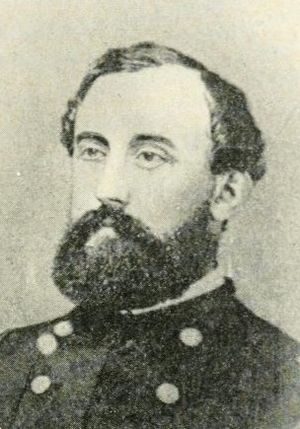George P. Foster facts for kids
- For the U.S. Representative from Illinois, see George Peter Foster.
Quick facts for kids
George Perkins Foster
|
|
|---|---|

From 1899's Foster Genealogy, Part 1.
|
|
| Nickname(s) | Fighting Colonel |
| Born | October 3, 1835 Walden, Vermont |
| Died | March 19, 1879 (aged 44) Burlington, Vermont |
| Place of burial |
Lakeview Cemetery Burlington, Vermont
|
| Allegiance | United States of America Union |
| Service/ |
United States Army Union Army |
| Years of service | 1861 - 1865 |
| Rank | |
| Commands held | 1st Vermont Brigade 4th Vermont Infantry |
| Battles/wars | American Civil War |
| Other work | US Marshal |
George Perkins Foster (October 3, 1835 – March 19, 1879) was an important person in American history. He was a school teacher before becoming a brave officer in the Union Army during the American Civil War. He reached the rank of Colonel and was later honored as a brevet brigadier general. After the war, he served his country as a United States Marshal.
Contents
Early Life and Career
George Perkins Foster was born in Walden, Vermont. His parents were Ephraim and Emily Foster. We don't know much about his early years. However, we do know that he worked as a teacher in his hometown.
Serving in the Civil War
George Foster joined the Union Army when the American Civil War began. He quickly showed he was a strong leader.
Joining the Army
On September 21, 1861, Foster became a captain in Company G of the 4th Vermont Infantry. He was promoted several times because of his skill.
- July 18, 1862: He became a major.
- November 5, 1862: He was promoted to lieutenant colonel.
- February 3, 1864: He became a colonel, taking over from Charles B. Stoughton.
A Fighting Colonel
George Benedict, a historian, described Foster as a very impressive officer. He was known for his strong build and good looks. More importantly, he was popular with his soldiers. He earned the nickname "fighting colonel" because he was so brave in battle.
Foster was involved in almost every major fight with the Vermont Brigade. He was seriously wounded in his leg on May 5, 1864. This happened during the first day of the Battle of the Wilderness.
While he was recovering from his injury, he got married. On July 5, 1864, he married Sarah Salome Hubbell in Wolcott, Vermont.
Key Battles and Leadership
Foster played a key role in several important battles:
- Battle at Lee's Mills: On April 16, 1862, he led a group of skirmishers. These soldiers were sent ahead to scout and fight lightly.
- Battle of Fredericksburg: On December 13, 1862, Lieutenant Colonel Foster led the 4th Vermont Infantry. They were on the front line during this tough battle.
- Battle of Winchester: Colonel Foster was in charge of the entire Vermont Brigade during this fight.
Becoming a Brigadier General
President Abraham Lincoln recognized Foster's bravery. On January 1, 1865, Lincoln suggested that Foster be given the honorary rank of brigadier general. This was for his "gallant and meritorious service" near Richmond and in the Shenandoah Valley. The Senate agreed to this on February 14, 1865.
Foster left the army with his regiment on July 13, 1865, after the war ended.
After the War: U.S. Marshal
After the Civil War, George Foster continued to serve his country.
Appointed U.S. Marshal
On January 10, 1870, President Ulysses S. Grant chose Foster to be the U.S. Marshal for Vermont. He officially started this job on January 24. He worked as a Marshal until he passed away.
A Famous Arrest
One of the most notable things Foster did as a Marshal was a bold arrest. He arrested General John O'Neill, a leader of the Fenian raids. These raids were attempts by Irish-American groups to invade Canada in 1870. Foster made the arrest right after O'Neill's group was defeated at the Battle of Trout River.
George Perkins Foster died in Burlington, Vermont. He is buried in Lakeview Cemetery in Burlington.

